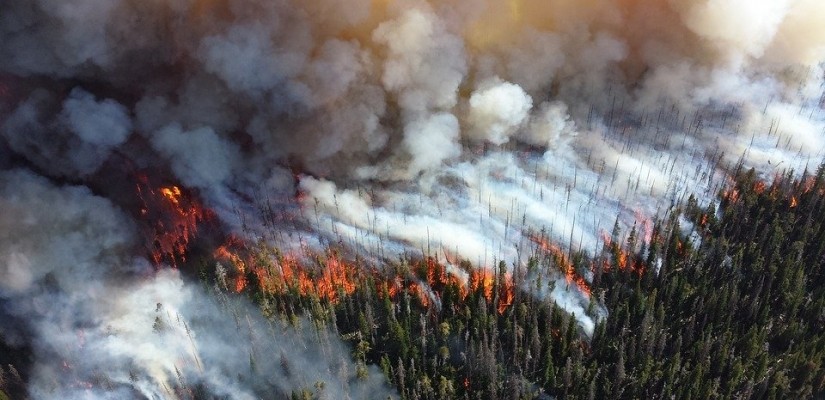Perhaps the greatest concern facing 2020 is that of climate change and the many risks associated with it. The world has been witnessing extreme weather events, such as flooding, hurricanes, heatwaves, droughts, wildfires, or winter storms, with increasing frequency. The occurrence of such extreme weather events can have a dramatic impact on supply chains and critical infrastructure, which are particularly vulnerable to climate risks.
In today’s business world, supply chains are globalized. While this allows for cheaper manufacturing costs, it also means that supply chains are more vulnerable to climate change than ever, considering that extreme weather events can happen anywhere on the planet. These extreme weather conditions can have serious effects on supply chains by damaging products or warehouses, causing delays in delivery, or increasing emergency response times, ultimately resulting in higher costs for consumers and greater uncertainty for producers. Moreover, extreme weather events can damage critical infrastructure, which can impact business operations. Therefore, businesses would be wise to relocate operations from zones with a high risk of extreme weather events.
Climate change also puts global biodiversity at risk. Rising temperatures worldwide negatively affect wildlife and ecosystems. The Living Planet Index, which tracks more than 4,000 species across the globe, reported a 60% decline in average abundance between 1970 and 2014. This loss in biodiversity is exacerbated by climate change. This results in damage to ecosystems like forests and oceans which are important for absorbing carbon emissions, further compounding the problem. Furthermore, the damage to ecosystems creates economic instability, especially for people who rely on these ecosystems for their livelihoods and food security.
Climate change is expected to impact crop yield, fisheries, animal farming, and food trade. Climate events and extreme temperatures are likely to cause a scarcity of essential resources, such as water and food, and adversely affect people’s livelihoods and living conditions. The UN highlights that climate change will negatively impact all dimensions of food security, which include availability, access, utilization, and stability, and will reduce public health outcomes.
Climate change will significantly lower the global production of wheat, rice, maize, and soybean, reducing food availability. Countries in the global north can anticipate an agricultural productivity increase, potentially creating surpluses. Meanwhile, countries in the global south will struggle with production losses and may have to import food to compensate for losses. Furthermore, ocean warming and acidification may negatively affect fisheries and aquacultures, posing risks to littoral livelihoods and industries. Finally, animal farmers may have to anticipate heat stress to livestock and higher demand for water.
Overall, food surpluses and deficits caused by climate change may alter food trade patterns and increase food trade in southern regions, which are projected to be most affected by food insecurity risks. Therefore, we can anticipate a growth in international food trade and potential increases in regional food prices due to climate change.

Satellite observations show that sea levels are rising almost everywhere on earth and that this increase is accelerating. As of January 2020, the rate of global sea-level change is measured at 3.3 millimeters per year and growing steadily. This sea-level rise is caused primarily by two factors related to global warming: the added water from melting ice sheets and glaciers, and the expansion of seawater as it warms. Ultimately, rising tides threaten to sink some coastal cities with devastating floods occurring with increasing frequency. In November 2019, Venice, Italy experienced a tide of 70 inches (1.778 meters), resulting in unprecedented flooding and billions of dollars in damage. Low-lying cities like Los Angeles, San Diego, Key West, Miami, Jacksonville, Savannah, and Honolulu are particularly vulnerable to rising sea levels. Furthermore, research suggests that economic impacts are highly concentrated geographically, where sea-level vulnerabilities interact with high-value property and infrastructure such as ports or powerplants. Thus, the frequency and severity of flooding in coastal cities can be expected to increase along with damage to infrastructure and debilitated operations.
Human Migration as a Result of Climate Change
One of the most important climate-related social developments to consider is that climate change will force people to relocate. Millions of people around the world will migrate due to more frequent and intense storms, floods, droughts, and heatwaves. Such large-scale movement of people will affect economies, state governments, international security, and natural resource management. Environmental changes and natural disasters have influenced human settlement patterns throughout history, yet climate change today may cause a rapid increase in human migration that could last for decades. The World Bank projects that approximately 143 million people in Sub-Saharan Africa (86 million), South Asia (40 million), and Latin America (17 million) will resettle by 2050 if no climate action is taken.
Climate-related migration will significantly weaken economic productivity. Estimations suggest that South Asia’s economy, for instance, may expect a loss of 1.8% of annual GDP by 2050 due to climate change. Large-scale migration will also put stress on international security and border control, potentially causing violent conflict. This may be aggravated by intra- and inter-state competition for water, food, and other resources.
In order to manage the risks of climate-related migration, the UN recommends that the availability and flexibility of channels for regular migration be improved. Planned relocations of communities and villages can enhance safety and reduce the unstructured diffusion of people. This requires long-term planning and domestic and international logistical cooperation.
While most scientists and activists would assert that the global community’s response to climate change has been woefully inadequate to effectively combat the problem, some governments around the world have begun taking steps to implement change on this front. Notably, the 2016 Paris Climate Agreement requires signatories to put forward measures to significantly reduce global greenhouse gas emissions, develop a framework for transparency and accountability, and achieve more ambitious targets. In addition, global regulators like the Financial Stability Board have established a Task Force on Climate-Related Financial Disclosures (TCFD) to push firms to develop consistent and effective financial disclosures so that stakeholders can properly assess the climate change-associated risks for businesses. Although President Trump has pulled the US out of the Paris Climate Agreement, states continue to pass legislation in response to climate change. For example, California requires insurers to disclose investments in fossil fuels. Businesses face increasing regulatory requirements to reduce their environmental impacts. Players that remain abreast of regulatory shifts and respond proactively have the opportunity to manage these changes while minimizing the impact of increased compliance costs, while those who fail to comply with regulations face extensive financial, reputational costs, and legal costs.

As climate change intensifies, fewer places are immune to its effects. When the frequency and magnitude of extreme weather events increases, so increases the damage done to homes and infrastructure. This results in substantial losses and risks for insurance companies. Over the course of two years (2017-2018), damage caused by natural disasters resulted in a record $225 billion of insured losses. Furthermore, the full extent of losses can often be assessed only months or years after the event, which may cause sudden surges in cost estimations.
For businesses and people looking to protect their assets, finding insurance against extreme weather events will likely become much more expensive and much more difficult. In response to more frequent and severe climate-related events, insurers are expected to raise their rates or refuse entirely to issue policies to individuals and operations in areas that are particularly vulnerable to the effects of climate change. For example, in the fire-prone regions across the Western United States, insurers are reducing their coverage. After the California Wildfires in 2019, some insurance companies incorporated new risk models and stopped insuring clients in high-risk areas. Moreover, government insurance programs, like those in the United States, are already strained and will have difficulty covering everyone in need as demand for insurance coverage increases. This precarious situation can result in a social issue, since low- and middle-income classes may not be able to bear the cost of more expensive insurance, but also may be unable to afford the cost of climate-related damage.
Climate change creates legal risk, particularly for corporations in the energy sector. Around the world, individuals, NGOs, and even shareholders are filing lawsuits against companies due to their alleged roles in contributing to climate change and inadequate response thereto.
For example, in the German case of Lliuya v. RWE AG, pending in the Higher Regional Court in Hamm, Germany, Peruvian farmer Saúl Lliuya sued German utility company RWE AG, alleging that, by knowingly emitting greenhouse gases, RWE has contributed to climate change. Lliuya, who lives in the flood path of Lake Palcacocha, asserts that glacial retreat caused by climate change threatens to cause the lake to overflow, posing a risk to his property and livelihood. While the success of the lawsuit remains to be seen, lawsuits like these have been filed around the world by a variety of actors, and defendant companies may bear significant litigation costs regardless of the outcome.
In the US, Pacific Gas & Electricity (PG&E), one of the country’s largest utility companies, filed for bankruptcy in early 2019 in anticipation of being held legally liable for over two years of devastating wildfires in California. It later settled for USD 11 billion with just some of the insurance companies seeking compensation for payouts they had made to homeowners and businesses after the wildfires. This occurred despite allegations by PG&E that climate change was at least a contributing factor to the fires, as a prolonged drought dried out much of the state and created conditions ripe for a severe fire. Thus, legal responses to climate change can result in serious financial, reputational, and regulatory risks for companies.
As awareness of the catastrophic consequences of climate change grows, so does the reputational risks for companies that contribute to climate change or take inadequate steps to combat it. Increasingly, customers have begun to reward companies for sustainability efforts and protest or boycott companies that fail to take steps to limit their carbon footprints. For example, a 2017 study indicated that 33% of individuals changed their purchasing habits based on the environmental reputation of the company, up from 11% in 2016. Furthermore, an increasing number of investors are demanding disclosure of a company’s climate risk and impact prior to making investment decisions. Conversely, the market may reward companies that willingly participate in “green” initiatives as stakeholders look to companies to reduce their environmental impact and pioneer an environmentally conscious, sustainable approach to business.
